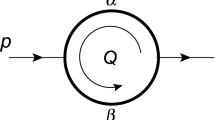Abstract
The interrelation of polylogarithmic functional equations and certain numerical results, known as “ladders”, is discussed, and leads to a consideration of three new, single-variable functional equations at the second order. Two of these families each contain six leading terms whose interrelationship constitutes a constraint on the integration process, but the third has only a single leading term with no such constraints. It is shown how this functional equation can be integrated to the third order, and the process reduced to an algorithm — actually a sequence of instructions — for incorporation into a computer program for symbolic manipulation. The procedure utilizes results from Kummer's equations to cancel out, in sequence, terms which do not vanish, or do vanish, with the variablez. Arguments are all of the form ±z p(1−z)q(1+z)r, and the process is “algebraicized” by using a (p,q,r,s) notation (withs=±1) to represent such terms. Application of the procedure leads to an integration to the fourth and fifth orders, the latter exhibiting 55 transcendental terms. The first step for the transition to the sixth order can also be achieved but the subsequent steps are frustrated by the restricted forms that the Kummer equations take at the fifth order — it is not possible to create the needed equations in a form which vanishes withz; this corresponding to the elimination of the ζ(5) constant in the extension of the numerically determined ladders to the sixth and higher orders. The existence of the higher-order ladders strongly suggests functional equations af these orders, but the present process has not yet been successful in finding them. The new equations have, however, produced ladders that were inaccessible from Kummer's equations, and had heretofore been only obtainable numerically, up to the fifth order. The method which was developed should be capable of generalization to other systems of equations characterized by the appearance of arguments with recurrent factors. Some new feature, however, will need to be determined before the barrier to the sixth order can be breached.
Similar content being viewed by others
References
Lewin, L.,The dilogarithm in algebraic fields. J. Austral. Math. Soc. (Ser. A)33 (1982), 302–330.
Lewin, L.,The inner structure of the dilogarithm in algebraic fields. J. Number Theory, vol. 193 (1984), 345–373.
Lewin, L., andAbouzahra, M.,The polylogarithm in algebraic number fields. J. Number Theory,21 (1985), 214–244.
Lewin, L.,The order-independence of the polylogarithmic ladder structure — implications for a new category of functional equations. Aequationes Math.30 (1986), 1–20.
Wechsung, G.,Über die unmöglichkeit der Vorkommens von Funktionalgleichungen gewissen Struktur für Polylogarithmen. Aequationes Math.5 (1970), 54–62.
MACSYMA. A large symbolic manipulation program developed at the MIT Laboratory for Computer Science. MACSYMA is a trademark of Symbolics, Inc.
Rogers, L. J.,On function sum theorems connected with the series Σ ∞1 x n n 2. Proc. London Math. Soc.4 (1907), 169–189.
Kummer, E. E.,Über die Transzendenten, welche aus wiederholten Integrationen rationaler Funktionen entstehen. J. Reine Angew. Math.21 (1840), 74–90, 193–225, 328–371.
Coxeter, H. S. M.,The functions of Schläfli and Lobatschefsky. Quart. J. Math. (Oxford)6 (1935), 13–29.
Philips, M. J. andWhitehouse, D. J.,Two-dimensional discrete properties of random surfaces. Philos. Trans. Roy. Soc. London Ser. A.305 (1982), 441–468.
Lewin, L.,Polylogarithms and associated functions. Elsevier, North-Holland New York-Amsterdam, 1981.
Lewin, L. andAbouzahra, M.,Polylogarithmic ladders to the sixth order for the base θ,(θ 3 +θ = 1). To be published.
Lewin, L. andAbouzahra, M.,Polylogarithmic ladders to the eighth order for the base ω,(ω 3 +ω 2 = 1). To be published.
Author information
Authors and Affiliations
Rights and permissions
About this article
Cite this article
Lewin, L., Rost, E. Polylogarithmic functional equations: A new category of results developed with the help of computer algebra (MACSYMA). Aeq. Math. 31, 223–242 (1986). https://doi.org/10.1007/BF02188191
Received:
Issue Date:
DOI: https://doi.org/10.1007/BF02188191



